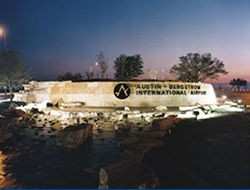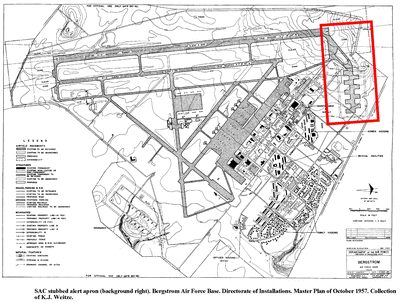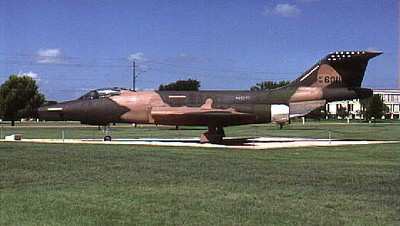The Military Points To Bergstrom And Says "Yes"
 Though the fear of losing jobs and
revenue grips nearby cities and towns when the Defense Department
decides to close a military installation, the bad news can be made
good.
Though the fear of losing jobs and
revenue grips nearby cities and towns when the Defense Department
decides to close a military installation, the bad news can be made
good.
Such was the case when Bergstrom Air Force Base here closed in
1993, its fate sealed by the 1991 Base Realignment and Closure
process.
Jim Halbrook, public information officer with Austins department
of aviation, was part of a transition team looking into how to make
the Air Force base a viable asset for the city. The view then, he
said, was "instead of this being bad news, lets make this an
opportunity."
"To use a cliche," he said, "how can we turn lemons into
lemonade?"
Bergstrom was home to two Air Force Reserve units, the 924th
Fighter Wing and Headquarters 10th Air Force. It also was home base
for the 67th Reconnaissance Wing of what was then the Air Force's
Tactical Air Command.
The 924th would remain at the airfield, but 10th Air Force moved
to Naval Air Station Fort Worth. The 67th emerged from the closure
as the 67th Intelligence Wing at Kelly Air Force Base, Texas.
According to DoD projections in 1993, expenditures at Bergstrom
were about $17.8 million a year, and closing the base would cut
costs by as much as $75.2 million between 1996 and 2001.
"The initial reaction was 'Oh no, our local Air Force base is
closing,'" said Halbrook. However, shortly after the base was put
on the list for closure, he said, the city became "proactive."
"Everybody got behind it really quick," he said. "There was a
lot of community support for it, and then the city went out to
Austin and the surrounding community with an educational process to
sell the community on its plan."
Shortly thereafter, the community approved, by 63 percent, $400
million in revenue bonds to convert Bergstrom Air Force Base to
Austin’s new airport facility.

As it turned out, Bergstrom’s closure was a positive for
Austin, he said.
The community at first lobbied to keep the base open, citing
among its many arguments that closing the base would result in loss
of jobs and an economic impact of more than $339 million yearly.
And, in fact, when Bergstrom closed in September 1993, it resulted
in the loss of 3,940 military and 927 civilian positions.
Though the 924th Fighter Wing did remain, it later was
deactivated as part of the 1995 BRAC process, bringing a final end
to military presence at the air base.
"Every community is, of course, different and affected
differently," Halbrook said. "But in our case, we actually
benefited from the closing."
The growing city was in need of a new airport to replace the
aging Robert Meuller municipal airport that had served the city
since the 1930s, he said, adding that when Bergstrom was listed as
a possible BRAC closure, the city "immediately started looking at
the airfield as a possible avenue for expansion."
"The timing was good for us, in turning what would have been bad
news into an opportunity," he said. "We were searching for a new
airport site, and it helped that the Defense Department worked with
us to make it happen.
"It didn't happen overnight; it was a long process to get it
built, but it has been a success story as far a redevelopment of a
base, as far as a base closure and the potential it can have for
opportunity," he said.
The Bergstrom-Austin International Airport, as it was named
after its conversion, opened for service in 1999, and now has 25
gates and serves 7.2 million passengers each year.
Halbrook said the successful conversion is one of the success
stories in how BRAC can benefit a community. He said the airport
has created thousands of jobs and billions of dollars in
revenue.
According to Halbrook, state and local taxpayers saved an
estimated $200 million in land acquisition and runway construction
costs alone by transforming the former Air Force base into the $690
million international airport.
The airport's contribution to the city is around $1.8 billion a
year, Halbrook said. "So it was taking something that would have
been missed and capitalizing when the timing was right," he said.
The airport created roughly 35,700 jobs, in addition to 21,500
"visitor-related" jobs in the local area.

The airport's success already has planners looking toward the
future.
When yearly passenger totals reach 8 million, Halbrook said, the
airport plans to add as many as 10 extra gates. If the total
surpasses 10 million passengers, "We will have to look at building
a new terminal," he added.
Although the airport's success has been astounding, Halbrook
said the impact of Bergstrom Air Force Base still is missed. "Any
time you lose $339 million — that's significant," he said.
"There is a lot of pride with having a military base within a
community; people take pride in that."
Fortunately for the city, he said, the loss was not as
devastating on the local community because the city had other
viable economic interests.
Austin is Texas's capital city and the hub of the state's
government. The city also is home to technology giants Dell
Computers and Texas Instruments. The University of Texas and
defense contractor Computer Science Corporation also are located
there.
Nevertheless, to lessen any economic loss to the city, Halbrook
said, planners left nothing to waste on its Bergstrom reuse
plan.
With the plans for a new airport under way, about half the land
from the old Robert Meuller airport was sold off to private
entities to build a new housing development.
The rest of Robert Meuller became the base for the city's new
film industry. "Some of the work for the movie ‘Spy Kids' was
shot inside one of the hangars at the old airport," he said.
At the former Bergstrom Air Force Base along Spirit of Texas
Avenue, the city kept many of the old buildings to be used again --
the airport's aviation department is one of many offices housed in
several of them. Other base structures, including hundreds of
military family housing units, were auctioned to private buyers and
moved off the base.
Halbrook said the city also was saved from building new runways
by keeping those already in place. The base's runways were capable
of handling heavy aircraft, like B-52 bombers. "That's an asset for
a city that wants to become an international airport to land really
large planes on," he said.
Paved roadways were reused, the materials from some of them
crushed to make roadbeds for new roads at the airport. The air
base's large fuel tanks also were kept for reuse. "We just
relocated them to the site where our fuel deport was located," he
said.
Aside from the few remaining buildings and hangars left over
from the conversion, the only signs of the base's past at this
modern facility are located at the pre-checkpoint side of the
terminal, where a small museum is located that tells the 52-year
history of the Air Force base.
And the Defense Department has found its way back on the air
base grounds it once owned.

Two Army National Guard units have taken up residence at the
south entrance of one of the airport's runways. Their presence,
Halbrook said, is only more good news for Bergstrom International
Airport and the city of Austin.
"Who do you call when there is an emergency or a disaster? Who
do you call to fill sandbags when there is a flood and storms?"
Halbrook asked. "It's a good thing that they are here, not only for
the airport and local community, but for all of central Texas as
well."
 ANN's Daily Aero-Linx (05.06.25)
ANN's Daily Aero-Linx (05.06.25) ANN's Daily Aero-Term (05.06.25): Ultrahigh Frequency (UHF)
ANN's Daily Aero-Term (05.06.25): Ultrahigh Frequency (UHF) ANN FAQ: Q&A 101
ANN FAQ: Q&A 101 Classic Aero-TV: Virtual Reality Painting--PPG Leverages Technology for Training
Classic Aero-TV: Virtual Reality Painting--PPG Leverages Technology for Training Airborne 05.02.25: Joby Crewed Milestone, Diamond Club, Canadian Pilot Insurance
Airborne 05.02.25: Joby Crewed Milestone, Diamond Club, Canadian Pilot Insurance






